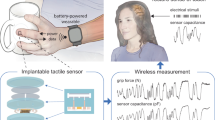Abstract
Anaesthesia of the hand can result from injury or disease. It severely impairs the normal use of the hand and brings with it the danger of accidental self-inflicted injury due to the absence of pain. A prosthetic device intended to overcome this non-correctable handicap will have to measure the pressure at the finger of the hand and produce a suitable stimulus that is a function of this pressure. The experimental device described uses flexible pressure sensors, based on the principle of the mercury strain gauge. An RC beat-frequency oscillator emits an audible sound whose frequency is a function of this pressure. The considerations for the design of the device are discussed and first results of the practical use are reported.
Sommaire
L'anesthésie de la main peut provenir d'une blessure ou d'une maladie. Elle altère gravement l'usage normal de la main et présente le danger de blessure accidentelle par suite de l'absence de douleur. Une prothèse voulant vaincre cet handicap irréversible devra mesurer la pression au niveau d'un doigt et produire un stimulus approprié fonction de cette pression. L'appareil expérimental décrit dans cet article utilise un capteur de pression flexible fondé sur le principe de la jauge de contrainte à mercure. Un oscillateur à fréquence de battement RC émet un son audible dont la fréquence est fonction de cette pression. On présente quelques considérations relatives à la conception de l'appareil, ainsi que les premiers résultats pratiques d'utilisation.
Zusammenfassung
Anästhesie der Hand kann auf Verletzung oder Krankheit beruhen. Der normale Gebrauch der Hand wird stark behindert. Wegen des fehlenden Schmerzgefühls besteht die Gefahr einer selbstverschuldeten Verletzung. Ein Prothesegerät zur Überwindung dieses nichtkorrigierbaren Fehlers muß den Druck am Finger messen und einen geeigneten Reiz als Funktion des Druckes erzeugen. Das hier beschriebene experimentelle Gerät benutzt flexible Drucksensoren, die auf dem Prinzip des Quecksilberdruckmessers beruhen. Ein RC-Schlagfrequenzoszillator sendet einen hörbaren Ton, dessen Frequenz eine Funktion des Druckes ist. Die Konstruktion dieses Gerätes wird diskutiert und die ersten Resultate der praktischen Anwendung werden mitgeteilt.
Similar content being viewed by others
References
Beeker, Th. W. et al. (1967) Artificial touch in a handprosthesis.Med. biol. Engng 5, 47–49.
Boone, J. L. (1966) Silicone rubber insulation for subdermally implanted devices.Med. Res. Engng. 5, 34–37.
Doull, J. A. (1960) Current status of the therapy of leprosy.J. Am. med. Ass. 173, 363–373.
Dow-Corning (1966) Silastic® Medical-Grade Tubing. Bulletin 14–119, Medical Products Division.
Elsner, R. W.,et al. (1959) Impedance matching circuit for the mercury strain gauge.J. appl. Physiol. 14, 871–872.
Fish, D. C. E. andCampbell, R. B. (1965) Strain gauge for large extensions. U.S. Patent No. 3, 332, 280.
Honda, N. (1962) Temperature compensation for mercury strain gauge used in plethysmography.J. appl. Physiol. 17, 572–574.
Kocmich, D. O. (1950) Variable electrical resistance device. U.S. Patent No. 2,518,906.
Manson-Bahr, P. H. (1966)Manson's Tropical Diseases. 16th ed., London.
Pfeiffer, E. A. andTerrell, D. H. (1967) A prosthetic device to provide tactile information from the anesthetic hand. Dig. 7 Intern. Conf. Med. Biol. Engng. 452 (Abstr.).
Pfeiffer, E. A. (1968) Electrical stimulation of sensory nerves with skin electrodes for research, diagnosis, communication and behavioral conditioning: A survey.Med. biol. Engng 6, 637–651.
Terrell, D. H. andPfeiffer, E. A. (1968) An instrumented pencil for psychomotoric studies.Biomedical Sci. Instrumation Vol. 4, Plenum Press.
Tims, E. F., et al. (1967) Substitute tactile senses for denervated limbs.Proc SWIEECO 11, 1–5.
Whitney, R. J. (1953) The measurement of volume changes in human limbs.J. Physiol., Lond. 121, 1.
Woolley, R. P. andHurry, J. A. (1953) High range strain gage. U.S. Patent No. 2,739,212.
Author information
Authors and Affiliations
Rights and permissions
About this article
Cite this article
Pfeiffer, E.A., Rhode, C.M. & Fabric, S.I. An experimental device to provide substitute tactile sensation from the anaesthetic hand. Med. & biol. Engng. 7, 191–199 (1969). https://doi.org/10.1007/BF02474175
Received:
Issue Date:
DOI: https://doi.org/10.1007/BF02474175




